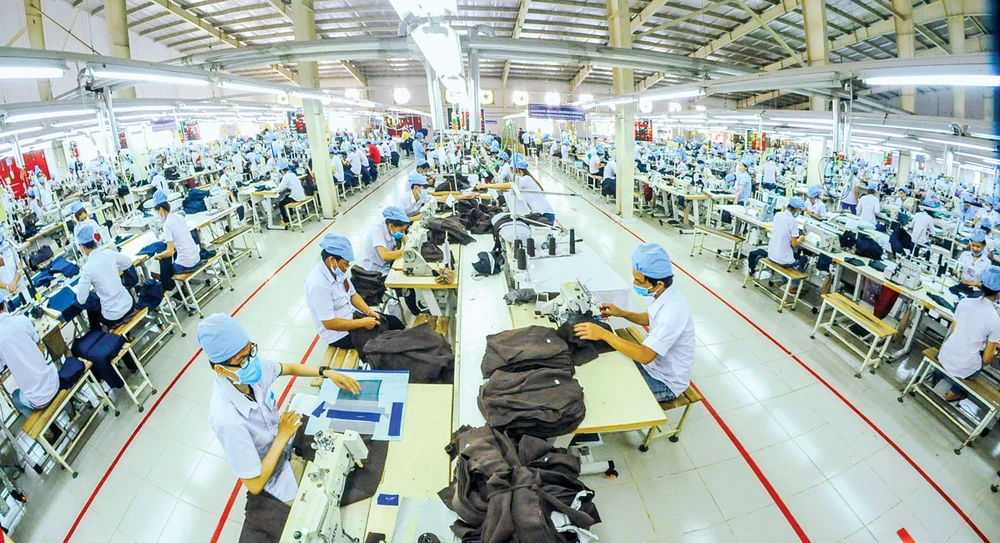
These will open up many opportunities for cooperation and trade for Vietnam, but also pose many challenges that will require Vietnam to gradually change the structure of its economy.
Setting realistic targets
The new generation FTAs will eliminate more than 99% of tariffs and create favorable conditions for exports to the EU market, such as in textiles, footwear, agriculture, fisheries, and wooden furniture. In addition, it is expected that through EVFTA, Vietnam's exports will increase by 20% within the next two years.
According to the General Statistics Office in Vietnam, during the period 2010-2018, exports to the EU market accounted for about 16-19% of all total exports. According to estimated figures, the share of Vietnam's exports to the EU market in 2017 were at 18% and in 2018 at 17%. Thus, in order for the total export turnover to increase to 20%, Vietnam's exports to the EU market must increase by around 200%. This is a very huge and unrealistic figure and given the current situation of Vietnam's manufacturing and export capacity, it is a figure that will be difficult to reach any time in the near future.
Currently, Vietnam's exports are basically centered around electronics, computers, components, and phone sets, accounting for more than 40% of all total exports. For these products at present Vietnam is still basically only just a manufacturing assembly line.
According to the General Statistics Office, in 2019, the strong development of the domestic economic sector in exports had a growth rate much higher than the growth rate of the Foreign Direct Investment sector (FDI), but the FDI sector still accounted for nearly 70% of total exports. Specifically, the domestic economic sector reached USD 82.10 bn, up by 17.7%, accounting for 31.2% of total export turnover; while FDI sector reached USD 181.35 bn, up by 4.2%, accounting for 68.8% of export turnover, a decrease of 2.5% compared to the previous year.
According to the principle of calculating GDP based on permanent residence, all labor and production surplus of enterprises producing these products are included in GDP. However, in fact, the Vietnamese side enjoys very little in price and export value of these products. The advantage that Vietnam actually benefits from is cheaper labor. Comparatively, a foreign manager’s salary is equivalent to that of wages of twenty Vietnamese workers.
In essence, exports in the FDI sector are those of the owner of the FDI enterprise who just borrow Vietnamese premises to export to another country or the owner’s home country by cashing in on the special incentives provided by Vietnam on land, taxes, and other policies. If these goods that are produced by the FDI sector are sold in Vietnam, they are actually exported to Vietnam. The profits from this mode of export are higher than the ones they produce for their own country, by taking advantage of the incentives and cheap labor costs.
Economic imbalance
The irony is that after so many years, despite showing an imbalance that needs adjustment, Vietnam's GDP growth is still heavily dependent on the FDI sector. This shows the paradox that an increase in GDP is actually an erosion of our resources.
In addition, when calculated from Vietnam's inter-industry balance sheet, it shows that the investment of the FDI sector and export of goods almost always spreads as their own surplus, but very rarely spreads to the domestic region. This also raises questions for economic observers and analysts. It seems that "two parallel economies exist" within the Vietnamese economy. The domestic and FDI economies seem independent of the Vietnamese economy.
In 2019, the Politburo issued Resolution No. 50 on the orientation to perfect institutions and policies, improve the quality and efficiency of foreign investment cooperation by 2030. In this Resolution, it was determined to actively attract and selectively cooperate foreign investment, and consider quality, efficiency, technology and environmental protection as the main evaluation criteria. This is a more joyful signal than FTAs, but the Resolution needs to be expressed in law. This is what Vietnam must improve on in the near future.
In addition, it is worth noting that when the new generation EVFTA is approved, it will eliminate more than 99% of tariffs. This will also reduce revenue from taxes on import of goods. The question rests on what Vietnam needs to do to fill this gap in budget revenue, and if people have to "piggyback" on the integration tax.
Economic figures of the last many years show that while exports have increased GDP, neither the people nor the Government have benefited much from exports. Basically, it looks like we are merely "helping" other countries with our exports, as these countries are reaping the actual benefits. This is a difficult problem in the economy that still does not have any solution.




















